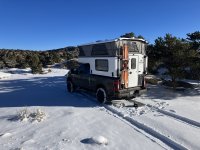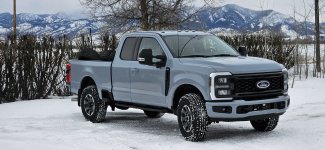knutsCO
New member
Hey fellas,
Thought you might be interested in some longish-term operational data from a fellow "tramper" (build #11).
Relevant configuration specs:
2022 F250 SCSB 7.3L gaser with 3.55 gears, 2" front leveling lift and rear Alcan spring packs
35x12.50 Toyo AT3 mounted on 17x9 Method wheels
Typical Axle Weights - 4500 lbs FA / 5000 Lbs RA
2WD front bumper valance
16k total miles since truck was delivered late July 2022
Camper was installed late Aug 2022 and has only been removed (temporarily) for maintenance
This is our second truck camper. Previous was a Northstar Laredo SC on a 2017 F350 SRW CCSB 6.7L diesel which we enjoyed for 2.5 years. See Northstar Laredo SC for relevant configuration details.
Our typical use case is frequent 3-4 day local Colorado trips for hiking, biking and skiing, several western US (Arizona, Utah, Wyoming, etc.) 10 day trips each year, and a longer multi-week XC trip each year to visit family in western NY. Typical speeds for us are 60-65 mph on 2 lane rural highways and posted limits on interstates.
Interestingly, we are seeing similar fuel economy with the F250 Supertramp pop-up vs the F350 Northstar hardside. Both configurations typically achieve(d) 12-14 mpg with a 13.2 mpg long-term average (16k miles) for the F250 gasser and 13.4 mpg long-term average (22k miles) for the F350 diesel. Both trucks have the standard 34 gallon fuel tank, allowing for a comfortable 400 mile range (in the absence of a strong head-wind or significant off-highway driving).
We have used both campers mid-winter in Colorado in single digit above/below 0F ambient temperatures. In fact, we just got back from a skiing trip where we spent a night on Wolf Creek Pass (10,800') during the last storm remnants from the "so called" atmospheric river event that has been pounding California and affecting weather across the desert SW for the past week. The temp dropped to about +5F that night with occasional wind gusts that I estimate were in the 30-40 mph range for several hours during the middle of the night. We awoke to 10' inches of fresh snow on the ground with drifts of 3+ feet in the leigh of the snow mounds surrounding the trailhead parking area at the top of the pass.
I have to say, I am very happy with the comfort and performance of the Supertramp pop-up in these mid-winter conditions. Condensation is almost absent in the Supertramp due to the breathability of the tent material. The only place we have noticed significant condensation is on the vinyl windows and the roof vent fans (to be expected). Previously with the Northstar it was necessary to ventilate to reduce humidity and cut down on condensation on the walls in the cab-over area at night. In similar winter conditions we always had to wipe down the walls in the Northstar bunk area to remove condensation in the morning. Definitely not the case in the Supertramp. To maintain a 50F delta (inside vs outside), I plan for 4 lbs propane/day, so with (2) 11 lb tanks it is possible to go for 4-5 days before refill in mid-winter conditions.
We have (2) 100Ah Battle Born (BB) batteries in our Supertramp. Our experience in cloudy mid-winter conditions suggest that it would be possible to go for 3 days with very limited solar input before recharging with the truck alternators is necessary. From this recent ski trip, I observed we were using about 60 Ah day (including using an electric kettle and Instapot). Typically, on a winter trip like this we only spend 2 nights at any one location, so recharging while driving to the next location has not been a problem. The lowest our battery bank got on this recent trip was 40%. I have removed the Victron DC/DC charger and installed #2 gauge welding cable between the trucks high current battery junction box and the camper bus bars. I control (on/off) the circuit with a high current relay connected to an upfitter switch (Ford factory installed accessory switch). While this set-up not ideal for all end-users, it works well for me since I don't mind monitoring the system while the circuit is energized. Additionally, I have observed that my alternator voltage set point is a very consistent 14.5V, which is an ideal terminal voltage for charging the BB batteries. I really don't have to worry about exceeding the recommended 14.6V maximum charging voltage for the BB camper batteries (BMS disconnect is 14.7V for the BB batteries). With the #2 conductors I typically see about a 60A initial charge rate that tapers as the BB battery voltage rises during charging. Once the BB battery voltage exceeds 14.4V the charge has tapered to less than a few amps. A couple of hours of driving is all that is required to top off the (2) BB batteries starting at 50% discharge.
Cheers,
Ken
Recent Ski Trip (Feb 5-9, 2024) - Overnight stop Penitente Canyon, Colorado BLM


My two favorite girls...

Tomichi Pass (11,962'), Colorado Aug 2022

Quartz Creek Meadow, Colorado Sep 2022

Bighorn Range, Wyoming Sep 2023

Near Hanksville, Utah Oct 2023

Thought you might be interested in some longish-term operational data from a fellow "tramper" (build #11).
Relevant configuration specs:
2022 F250 SCSB 7.3L gaser with 3.55 gears, 2" front leveling lift and rear Alcan spring packs
35x12.50 Toyo AT3 mounted on 17x9 Method wheels
Typical Axle Weights - 4500 lbs FA / 5000 Lbs RA
2WD front bumper valance
16k total miles since truck was delivered late July 2022
Camper was installed late Aug 2022 and has only been removed (temporarily) for maintenance
This is our second truck camper. Previous was a Northstar Laredo SC on a 2017 F350 SRW CCSB 6.7L diesel which we enjoyed for 2.5 years. See Northstar Laredo SC for relevant configuration details.
Our typical use case is frequent 3-4 day local Colorado trips for hiking, biking and skiing, several western US (Arizona, Utah, Wyoming, etc.) 10 day trips each year, and a longer multi-week XC trip each year to visit family in western NY. Typical speeds for us are 60-65 mph on 2 lane rural highways and posted limits on interstates.
Interestingly, we are seeing similar fuel economy with the F250 Supertramp pop-up vs the F350 Northstar hardside. Both configurations typically achieve(d) 12-14 mpg with a 13.2 mpg long-term average (16k miles) for the F250 gasser and 13.4 mpg long-term average (22k miles) for the F350 diesel. Both trucks have the standard 34 gallon fuel tank, allowing for a comfortable 400 mile range (in the absence of a strong head-wind or significant off-highway driving).
We have used both campers mid-winter in Colorado in single digit above/below 0F ambient temperatures. In fact, we just got back from a skiing trip where we spent a night on Wolf Creek Pass (10,800') during the last storm remnants from the "so called" atmospheric river event that has been pounding California and affecting weather across the desert SW for the past week. The temp dropped to about +5F that night with occasional wind gusts that I estimate were in the 30-40 mph range for several hours during the middle of the night. We awoke to 10' inches of fresh snow on the ground with drifts of 3+ feet in the leigh of the snow mounds surrounding the trailhead parking area at the top of the pass.
I have to say, I am very happy with the comfort and performance of the Supertramp pop-up in these mid-winter conditions. Condensation is almost absent in the Supertramp due to the breathability of the tent material. The only place we have noticed significant condensation is on the vinyl windows and the roof vent fans (to be expected). Previously with the Northstar it was necessary to ventilate to reduce humidity and cut down on condensation on the walls in the cab-over area at night. In similar winter conditions we always had to wipe down the walls in the Northstar bunk area to remove condensation in the morning. Definitely not the case in the Supertramp. To maintain a 50F delta (inside vs outside), I plan for 4 lbs propane/day, so with (2) 11 lb tanks it is possible to go for 4-5 days before refill in mid-winter conditions.
We have (2) 100Ah Battle Born (BB) batteries in our Supertramp. Our experience in cloudy mid-winter conditions suggest that it would be possible to go for 3 days with very limited solar input before recharging with the truck alternators is necessary. From this recent ski trip, I observed we were using about 60 Ah day (including using an electric kettle and Instapot). Typically, on a winter trip like this we only spend 2 nights at any one location, so recharging while driving to the next location has not been a problem. The lowest our battery bank got on this recent trip was 40%. I have removed the Victron DC/DC charger and installed #2 gauge welding cable between the trucks high current battery junction box and the camper bus bars. I control (on/off) the circuit with a high current relay connected to an upfitter switch (Ford factory installed accessory switch). While this set-up not ideal for all end-users, it works well for me since I don't mind monitoring the system while the circuit is energized. Additionally, I have observed that my alternator voltage set point is a very consistent 14.5V, which is an ideal terminal voltage for charging the BB batteries. I really don't have to worry about exceeding the recommended 14.6V maximum charging voltage for the BB camper batteries (BMS disconnect is 14.7V for the BB batteries). With the #2 conductors I typically see about a 60A initial charge rate that tapers as the BB battery voltage rises during charging. Once the BB battery voltage exceeds 14.4V the charge has tapered to less than a few amps. A couple of hours of driving is all that is required to top off the (2) BB batteries starting at 50% discharge.
Cheers,
Ken
Recent Ski Trip (Feb 5-9, 2024) - Overnight stop Penitente Canyon, Colorado BLM


My two favorite girls...

Tomichi Pass (11,962'), Colorado Aug 2022

Quartz Creek Meadow, Colorado Sep 2022

Bighorn Range, Wyoming Sep 2023

Near Hanksville, Utah Oct 2023









